Lithography on paper by Charles Fichot (French, 1817 – 1903), published in a supplement to the Illustrated London News of July 6, 1867.
The construction on the foreground is the International Exposition of 1867 (Exposition universelle d'art et d'industrie de 1867). Dimensions: Sheet: 130 x 58 cm; Image: 118 x 43 cm.-

-
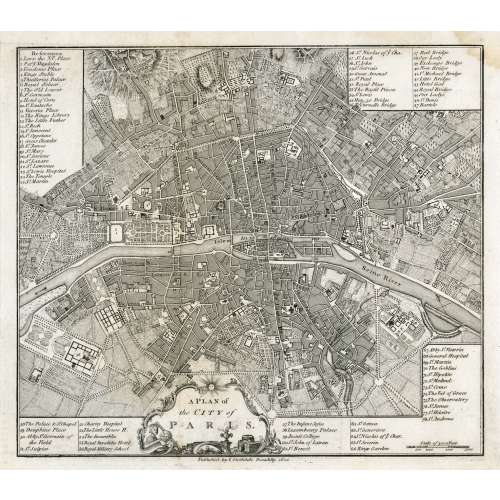 In pictorial frame: A PLAN of | the CITY of PARIS. || Under the border: Published by I. Stockdale Piccadilly 1800 || Dimensions: Sheet: 29 x 34.5 cm; Image: 22.7 x 25.9 cm.
In pictorial frame: A PLAN of | the CITY of PARIS. || Under the border: Published by I. Stockdale Piccadilly 1800 || Dimensions: Sheet: 29 x 34.5 cm; Image: 22.7 x 25.9 cm. -
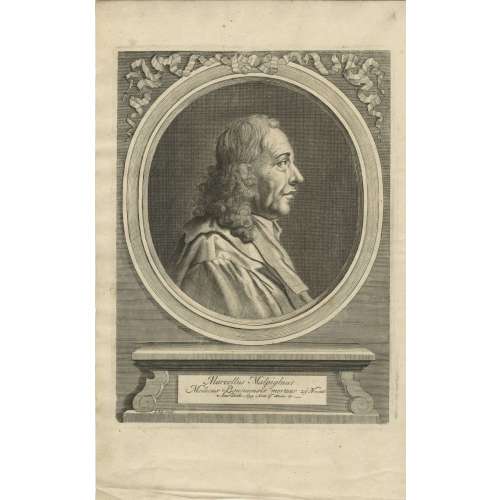
A portrait of Marcello Malpighi from his book Opera posthuma: figuris aeneis illustrata, quibus praefixa est ejusdem vita a seipso scripta, Londini:Churchill, 1697. Inscription: Marcellus Malpighius | Medicus Bononiensis mortuus 29 Novemb. Anno Dom. 1694. Anno aetatis 67. I. Kip. sculp.
Marcello Malpighi (10 March 1628 – 29 November 1694) was an Italian biologist and physician, who is referred to as the "Father of microscopical anatomy, histology, physiology and embryology" [Wikipedia].
From European Journal of Anatomy 22(5):433-439 · September 2018, an article by Sanjib Ghosh and Ashutosh Kumar 'Marcello Malpighi (1628-1694): Pioneer of microscopic anatomy and exponent of the scientific revolution of the 17th Century': Italian anatomist and an eminent scientist who significantly contributed to the advancement of the anatomical sciences in the 17th century. Malpighi was one of the first to use the compound microscope (an instrument designed by Galileo in 1609) and made the most important discovery of his life in 1661 when he identified capillaries as connecting vessels between small arteries and veins in the lungs. Malpighi thus provided the missing link in William Harvey's theory of blood circulation. He made significant contributions in the field of embryology based on his observations on chick embryo, and his efforts provided deep insights into the development of the heart and the nervous system. His communications based on microscopic studies scripted valuable details on the structural organization of organs like the liver, kidney and spleen. He identified the hepatic lobule as the fundamental unit of the liver and noted that bile was being secreted by these lobules and not from the gall bladder (the popular belief then). In the kidney, he discovered the glomerulus (Malpighian Corpuscle) and was the first to observe the convoluted tubules in the renal cortex. He was the first to describe the presence of lymphatic bodies (Malpighi's Corpuscle) in the spleen. Although he was exceedingly successful in his scientific activities, his life was fraught with unfortunate events and savage criticism from detractors arising out of professional jealousy and personal feuds. Nevertheless, his exploits were instrumental in understanding the human microscopic anatomy (histology) and his accomplishments have etched his name in the pages of medical science forever.
The portrait was engraved by Johannes "Jan" Kip (1652/53, Amsterdam – 1722, Westminster) - a Dutch draftsman, engraver and print dealer.
-
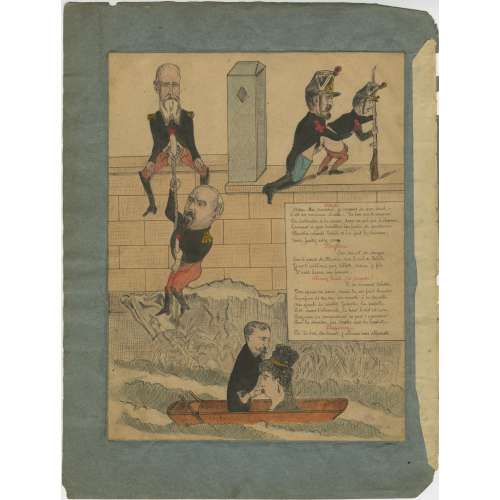 A series of seven political caricatures with indecent content, ink and pigment on paper, bound in a grey-blue folder. Each drawing is pasted to a grey-blue sheet of paper 32 x 24 cm. PLATES: 1) Villette; Bazaine; Alvarez Rull: 250 x 192 mm
A series of seven political caricatures with indecent content, ink and pigment on paper, bound in a grey-blue folder. Each drawing is pasted to a grey-blue sheet of paper 32 x 24 cm. PLATES: 1) Villette; Bazaine; Alvarez Rull: 250 x 192 mm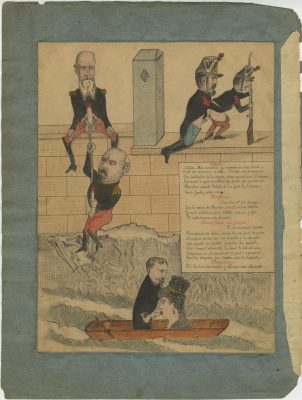
Villette Adieu, cher maréchal, je réponds de mon dard C’est un morceau d’acier… Là bas, sur le rempart, Sa cartouche à la main, dans un cul qui le charme, Lançant à gros bouillons son foutre de gendarme Plantin plante Delille et lui font le Caisson. Bazaine Sur ton vit de dragon Sur le nœud de Plantin, sur le cul de Delille, Je ne t’oublierai pas, Villette, adieu, je file Et je vais baiser ma femme. Alvarez Rull (à Josépha) Il ne saurait tarder, Ton epoux va venir, mais tu me fais bander, Le parfum de ton con me monte à la cervelle, Ma gaule se raidit . Josépha, la nacelle Est dans l’ obscurité, là haut, le ciel est noir, Bazaine en descendant ne peut t’ apercevoir … Pour la dernière fois, torche moi la houlette. Bazaine Eh ! là bas, du canot, j’allume une allumette!
Villette Farewell, dear Marshal, I vouch for my dick. It’s like a steel rod … Over there, on the ramparts, Plantin, his dick in hand, pounds Delisle’s beckoning ass And fills it with his bubbling gendarme’s cum. Bazaine For your dragoon’s dick, For Plantin's prick, for Delisle's ass, I won't forget you, Villette, goodbye, I'm leaving And I'm going to fuck my wife. Alvarez Rull (to Josépha) Hurry up, Your husband is coming, but I got a hard on you, The scent of your cunt penetrates my brain, My rod stiffened. Josépha, the gondola Is in the dark, the sky is black, Bazaine coming down and cannot see you... Give me one last blowjob.Bazaine Hey! Over there, from the canoe, I light a match!
French marshal Achille Bazaine capitulated to Bismarck during the Franco-Prussian war on 27 October 1870. In 1873, he was tried for treason and received a death sentence, later commuted to 20 years' imprisonment. Bazaine was incarcerated in the Fort Royal on Île Sainte-Marguerite, from which he escaped on August 9–10, 1874, with the help of Colonel Villette [Willette], his wife Josefa [Pepita Peña], and her nephew Alvarez Rull. They sailed to Genoa in Italy and from there to London. Plantin and Delisle were prison guards. The story was described in detail during the Trial of Col. Villette and his Accomplices in 1874 and published later in Robert Christophe. La Vie tragique du maréchal Bazaine. — Paris: Vautrain Jacques, 1947.
2) Impératrice Eugénie: 218 x 165 mm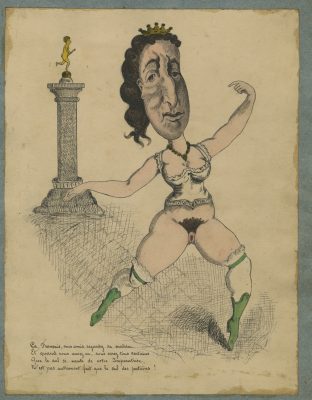
Ça, Français, mes amis, regardez sa matrice, Et quand vous aurez vu, vous serez tous certains Que le cul si vanté de votre Impératrice, N’est pas autrement fait que le cul des putains!
That, French, my friends, look at her cunt, And when you have seen, you will all be certain That the so acclaimed ass of your Empress, Is no different than the ass of whores! 3) Napoléon III: 215 x 168 mm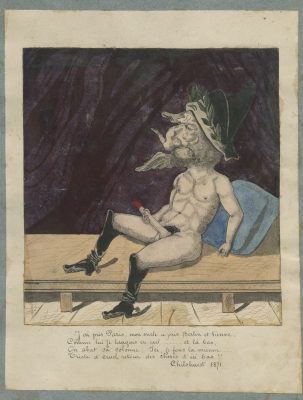
J’ai pris Paris, mon oncle a pris Berlin et Vienne. Comme lui je languis en exil …… et là bas, On abat sa colonne; Ici, je fous la mienne…. Triste et cruel retour des choses d’ici bas!! Chilshurst 1871. [i.e. Chislehurst]
I took Paris, my uncle took Berlin and Vienna. Like him, I, too, languish in exile. His column there was demolished; I’m jerking mine off here…. Cruel and sorrowful deeds!! 4) La confession: 216 x 168 mm (Georges Darboy?)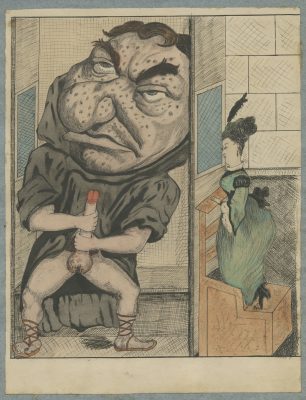 5) Napoléon III et Thérèsa (chanteuse Désirée Emma Valladon): 216 x 176 mm
5) Napoléon III et Thérèsa (chanteuse Désirée Emma Valladon): 216 x 176 mm
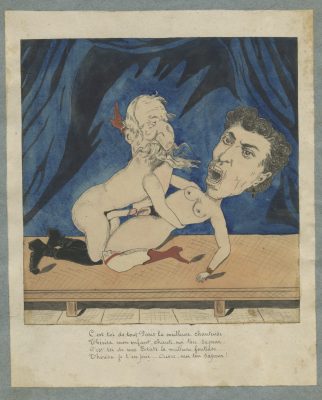
C’est toi de tout Paris la meilleure chanteuse, Thérèsa mon enfant, chante-moi ton sapeur. C’est toi de mes Etats la meilleure fonteuse.. Thérèsa je t’en prie … Ouvre-moi ton sapeur!
You, the best singer in all of Paris, Teresa, my child, sing for me where to insert. You are the best padding in my entire country… Teresa, please... Open your slit for me! 6) Thiers: 219 x 168 mm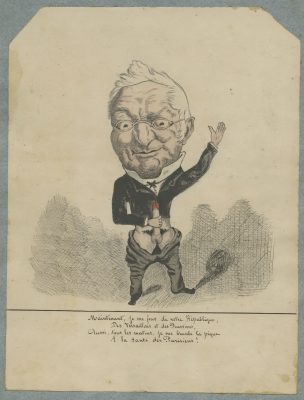
Maintenant, je me fous de votre République, Des Versaillais et des Prussiens, Aussi, tous les matins, je me branle la pique A la santé des Parisiens!
Yes, I don’t care about your Republic now, About Versailles and the Prussians, And every morning I jerk off For the health of Parisians! 7) Émile Ollivier/Rochefort/Jules Favre/Gambetta : 212 x 168 mm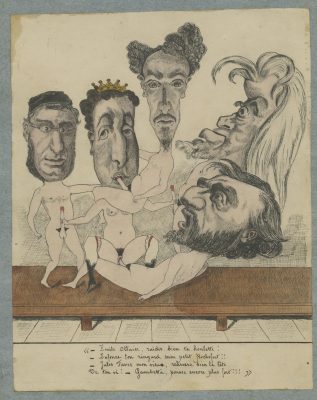
« — Emile Ollivier, raidis bien la houlette! — Enfonce ton ringard mon petit Rochefort!! — Jules Favre mon vieux, redresse bien la tête De ton vi! — Gambetta, pousse encore plus fort!!! »
Emile Ollivier, tighten your dick! - Stick in your poker, my little Rochefort!! - Jules Favre, old man, straighten your dickhead Damn it! – Gambetta, push even harder!!!Characters: Bazaine, François Achille (French, 1811 – 1888) Darboy, Georges (French, 1813 – 1871) Favre, Jules (French, 1809 – 1880) Gambetta, Léon (French, 1838 – 1882) Montijo, Eugénie de (Spanish-French, 1826 – 1920) Napoleon III [Bonaparte, Charles-Louis Napoléon] (French, 1808 – 1873) Ollivier, Émile (French, 1825 – 1913) Peña Azcárate, Josefa [Peña, Pepita] (Mexican-French, 1847 – 1900); Alvarez Rull – nephew of Josefa Peña Azcárate. Rochefort, Henri (French, 1831 – 1913) Thérésa [Valladon, Désirée Emma] (French, 1836 – 1913) Thiers, Adolphe (French, 1797 – 1877)
-
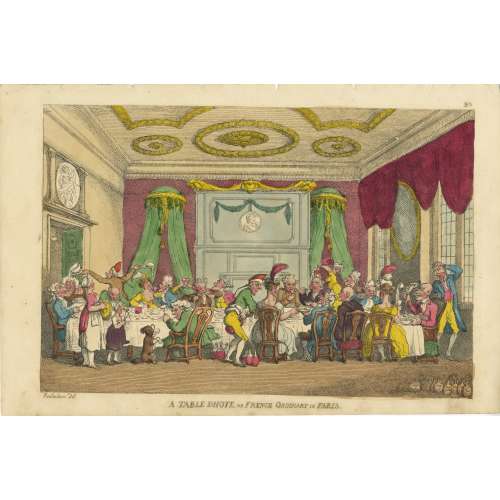 Hand-coloured etching by Thomas Rowlandson, printed on May 30, 1810, in London; № 20 from the series The Caricature Magazine or Hudibrastic Mirror Vol. 2. Description by Metropolitan Museum (59.533.978): "Guests of a dinner sit at a long narrow table in a magnificent room with an ornate ceiling. Two men and a young woman serve wine, one drawing a cork, the others spilling wine over the guests. Another waiter spills soup in an elderly guest's face. A woman and a little girl with a begging dog play tambourine and triangle at left." Inscribed in plate lower left: "Rowlandson Del."; bottom centre: "A TABLE DHOTE, OR FRENCH ORDINARY IN PARIS." Our copy is lacking the publication details: "Pub.d May 30. 1810 by Tho.s Tegg 111 Cheapside, London." and similar to the copy in Boston Public Library (18_03_000394). Dimensions: Sheet 27 x 40.5 cm; Image: 23.5 x 35 cm. Contributors: Thomas Rowlandson (British, 1756 – 1827) – artist. Thomas Tegg (British, 1776 – 1846) – publisher.
Hand-coloured etching by Thomas Rowlandson, printed on May 30, 1810, in London; № 20 from the series The Caricature Magazine or Hudibrastic Mirror Vol. 2. Description by Metropolitan Museum (59.533.978): "Guests of a dinner sit at a long narrow table in a magnificent room with an ornate ceiling. Two men and a young woman serve wine, one drawing a cork, the others spilling wine over the guests. Another waiter spills soup in an elderly guest's face. A woman and a little girl with a begging dog play tambourine and triangle at left." Inscribed in plate lower left: "Rowlandson Del."; bottom centre: "A TABLE DHOTE, OR FRENCH ORDINARY IN PARIS." Our copy is lacking the publication details: "Pub.d May 30. 1810 by Tho.s Tegg 111 Cheapside, London." and similar to the copy in Boston Public Library (18_03_000394). Dimensions: Sheet 27 x 40.5 cm; Image: 23.5 x 35 cm. Contributors: Thomas Rowlandson (British, 1756 – 1827) – artist. Thomas Tegg (British, 1776 – 1846) – publisher. -
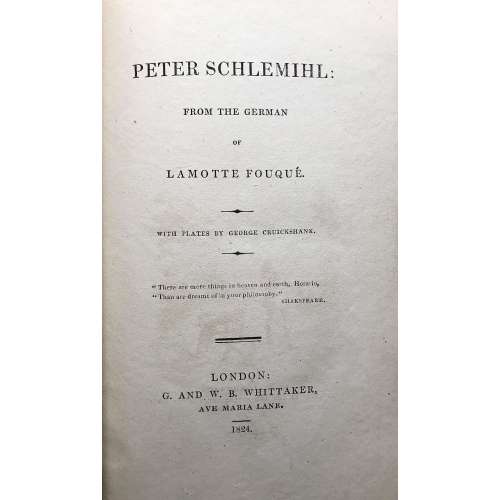 Title: PETER SCHLEMIHL: | FROM THE GERMAN | OF LAMOTTE FOUQUÉ | WITH PLATES BY GEORGE CRUICKSHANK. | "There are more things in heaven and earth, Horatio, | "Than are dreamt of in your philosophy." | SHAKESPEARE. | — | LONDON: | G. AND W. B. WHITTAKER, | AVE MARIA LANE. | 1824.|| Pagination: xii, 165 p. : ill. No Adelbert von Chamisso (German, 1781 – 1838) name on the title page. George Cruikshank's name printed with a typo 'Cruickshank'. The attribution on the title-page to Friedrich de La Motte-Fouqué (German, 1777 – 1843) is erroneous. The original German was edited by La Motte Fouqué. The translation was performed by Sir John Bowring (British, 1792 – 1872) First edition in English, third issue with no hyphen between "Ave" and 'Maria" in publisher's imprint.
Title: PETER SCHLEMIHL: | FROM THE GERMAN | OF LAMOTTE FOUQUÉ | WITH PLATES BY GEORGE CRUICKSHANK. | "There are more things in heaven and earth, Horatio, | "Than are dreamt of in your philosophy." | SHAKESPEARE. | — | LONDON: | G. AND W. B. WHITTAKER, | AVE MARIA LANE. | 1824.|| Pagination: xii, 165 p. : ill. No Adelbert von Chamisso (German, 1781 – 1838) name on the title page. George Cruikshank's name printed with a typo 'Cruickshank'. The attribution on the title-page to Friedrich de La Motte-Fouqué (German, 1777 – 1843) is erroneous. The original German was edited by La Motte Fouqué. The translation was performed by Sir John Bowring (British, 1792 – 1872) First edition in English, third issue with no hyphen between "Ave" and 'Maria" in publisher's imprint.In a cover box of red cloth over cardboard. Box: 21 x 13 x 2.3 cm; book: 19.3 x 11.8 x 1.7 cm; Crown 8vo. Red cardboard binding. Printed spine labels mounted on spine of the box and the book. Untrimmed edges.
Reference: Cohn 475. -
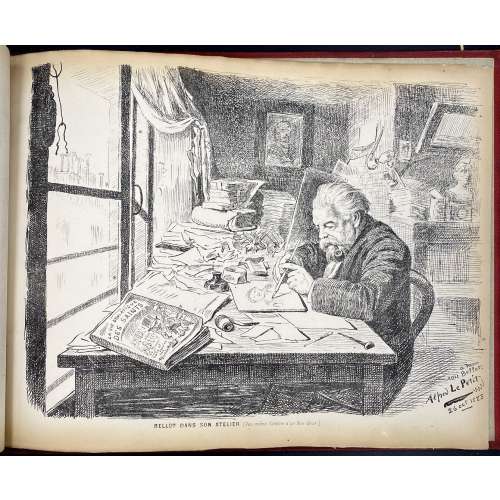 An album of the "Le Bon-Bock" dinners for the year 1884. Author, designer and publisher – Emile Bellot (French, 1831 – 1886), a Parisian artist and engraver. "Le Bon-Bock" was a monthly dinner of artists and men of letters, who gathered in Paris for good food, good company, and artistic performances, from 1875 to at least 1925. The story behind these gatherings as told by Emile Bellot, the founder, is this:
An album of the "Le Bon-Bock" dinners for the year 1884. Author, designer and publisher – Emile Bellot (French, 1831 – 1886), a Parisian artist and engraver. "Le Bon-Bock" was a monthly dinner of artists and men of letters, who gathered in Paris for good food, good company, and artistic performances, from 1875 to at least 1925. The story behind these gatherings as told by Emile Bellot, the founder, is this:In February 1875, Pierre Cottin1 came to me and said: 'I discovered a poet and tragedian of immense talent and who interprets the poems of the Great Victor Hugo in an astonishing way. Monsieur Gambini. I promised him that I would make it heard by an audience of artists and men of letters. I am counting on you who have many connections to keep my promise to him'. I gathered about 25 of my friends and acquaintances in a picnic dinner which took place at a restaurant 'Krauteimer' on the rue Rochechouart in Montmartre. They heard from Mr Gambini first, then my friends Étienne Carjat2, J. Gros3, Adrien Dézamy4, etc. performed. These gentlemen completed the evening so brilliantly that it was unanimously decided that we would start a similar dinner every month. Poets, musicians, men of letters, singers would be invited to this dinner. I was in charge of the organization of this little party and as it was the dream of my life to bring together old comrades, I was careful not to refuse and I pursued this good idea. Cottin and René Tener5 were kind enough to help me in this joyous task and especially my old friend Carjat. The following March began our 1st monthly dinner.
The name "Le Bon-Bock" means "The Good Bock", whilst Bock is a kind of beer, a dark, malty, lightly hopped ale. The dinner was named "Le Bon-Bock" in honour of the Éduard Manet painting (1873), a famous portrait of Emile Bellot, called "Le Bon-Bock".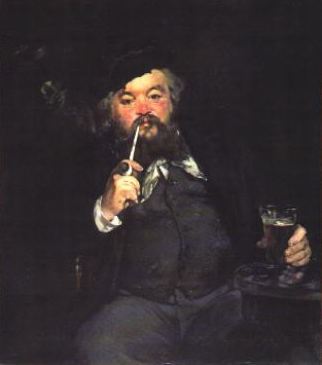 The invitations to the dinner were also produced by the artists and looked like this one by Alexandre Ferdinandus (October 3, 1883).
The invitations to the dinner were also produced by the artists and looked like this one by Alexandre Ferdinandus (October 3, 1883).
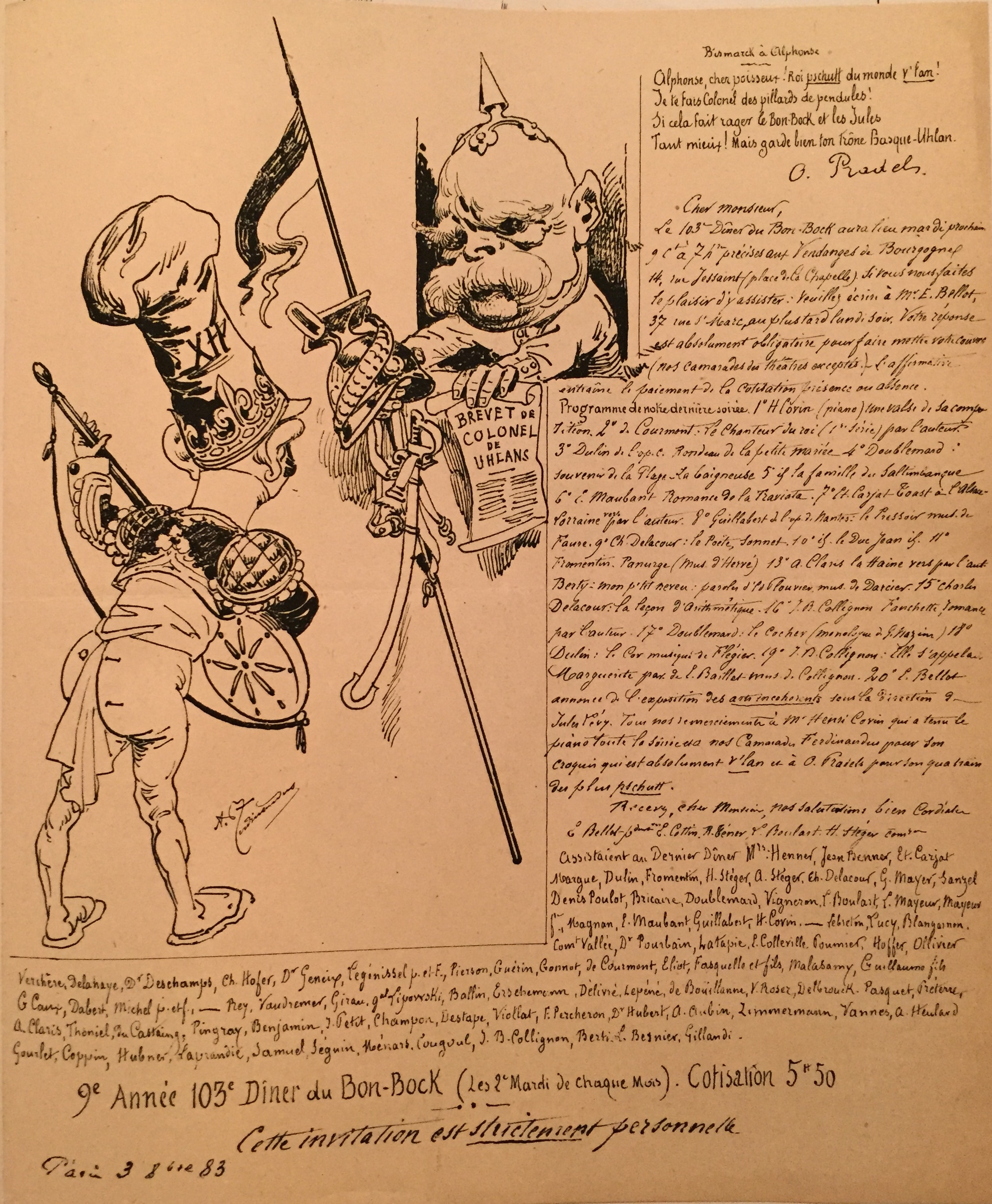 Besides this sketch of the Parisian social and artistic life at the end of the 19th century, the provenance of the album in our collection generates additional interest. The ink stamp to the front flyleaf reads: "Docteur Henry Uzan, 29 Avenue Perrichont, Paris XVI".
Doctor Henry Uzan was Jewish. He was arrested by the Pétain police on October 1, 1941, and interned in Drancy. With the few means at his disposal, he undertook to treat the sick whom he then saw leaving, week after week, towards their terrible destiny in the extermination camps. In October 1943 doctor Uzan was deported to the island of Alderney. After the Normandy Landing of June 6, 1944, Nazis evacuated the island detainees and transfer them to the Neuengamme camp, via northern France and Belgium. During the transfer, doctor Uzan managed to escape from the train on the night of September 3 to 4 around Dixmude in Flanders. He was taken in by the Belgian Resistance, which he joined before being repatriated to France.
In France, he continued working as a physician and was one of the founders of Association des internés et déportés politiques (AIDP). In 1945, together with his friends, the doctor designed the symbol for the Fédération nationale des déportés et internés résistants et patriotes:
Besides this sketch of the Parisian social and artistic life at the end of the 19th century, the provenance of the album in our collection generates additional interest. The ink stamp to the front flyleaf reads: "Docteur Henry Uzan, 29 Avenue Perrichont, Paris XVI".
Doctor Henry Uzan was Jewish. He was arrested by the Pétain police on October 1, 1941, and interned in Drancy. With the few means at his disposal, he undertook to treat the sick whom he then saw leaving, week after week, towards their terrible destiny in the extermination camps. In October 1943 doctor Uzan was deported to the island of Alderney. After the Normandy Landing of June 6, 1944, Nazis evacuated the island detainees and transfer them to the Neuengamme camp, via northern France and Belgium. During the transfer, doctor Uzan managed to escape from the train on the night of September 3 to 4 around Dixmude in Flanders. He was taken in by the Belgian Resistance, which he joined before being repatriated to France.
In France, he continued working as a physician and was one of the founders of Association des internés et déportés politiques (AIDP). In 1945, together with his friends, the doctor designed the symbol for the Fédération nationale des déportés et internés résistants et patriotes:
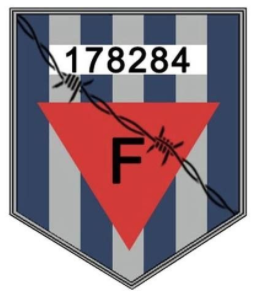 The story behind the number on the emblem (178284) is fascinating but it is out of the scope of this material.
The story behind the number on the emblem (178284) is fascinating but it is out of the scope of this material.
1. Pierre Cottin (French, 1823 – c. 1887) – Engraver, mezzotinter, genre and landscape painter; born in Chappelle-Saint-Denis (near Paris), a pupil of Jazet. Exhibited at the Salon from 1845, also in London from 1876 to 1879.↩ 2. Étienne Carjat (French, 1828 – 1906) – Journalist, caricaturist and photographer. ↩ 3. Jean Baptiste Louis Gros (French, 1793 – 1870) – Painter. ↩ 4. Adrien Dézamy (French, 1844 – 1891) – Writer, poet, general secretary of the Théâtre des Bouffes in Paris. ↩ 5. Rene Tener (French, 1846 – 1925) – Painter. ↩ Sources:Auguste Lepage. Les dîners artistiques et littéraires de Paris / Bibliothèque des Deux mondes (2e éd.) – Paris: Frinzine, Klein et Cie., 1884. [Accession № LIB-2606.2021 in this collection]
-
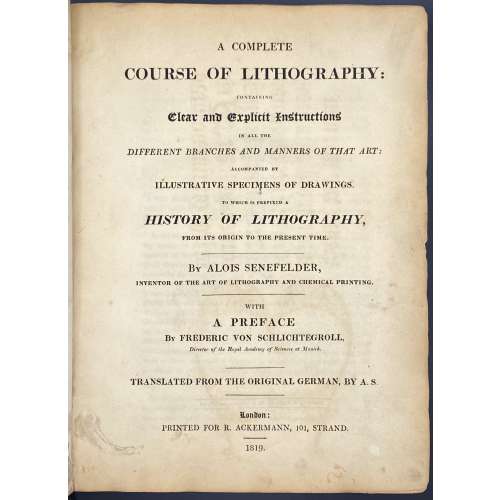 Title: A COMPLETE | COURSE OF LITHOGRAPHY: | CONTAINING | Clear and Explicit Instructions | IN ALL THE | DIFFERENT BRANCHES AND MANNERS OF THAT ART | ACCOMPANIED BY | ILLUSTRATIVE SPECIMENS OF DRAWINGS. | TO WHICH IS PREFIXED A | HISTORY OF LITHOGRAPHY, | FROM ITS ORIGIN TO THE PRESENT TIME. | By ALOIS SENEFELDER, | INVENTOR OF THE ART OF LITHOGRAPHY AND CHEMICAL PRINTING. | WITH | A PREFACE | By FREDERIC VON SCHLICHTEGROLL, |Director of the Royal Academy of Sciences at Munich. | TRANSLATED FROM THE ORIGINAL GERMAN, BY A.S. | London: | PRINTED FOR R. ACKERMANN, 101 STRAND. | 1819. || Pagination: [i-iii] iv-xxviii, [4] [1] 2-342. Collation: 4to; [a]-d4, B-2U4 2X2, +14 lithographed plates by Ackermann (incl. 1 folding, 1 colour frontispiece and 1 portrait of A. Senefelder); plates opposite to pp. [i], [1], 193, 198, 203, 228, 232 (fold.), 256, 258, 264, 269, 290, 302, and 305. Binding: By Anne Krawitz (Philadelphia, PA), 27.5 x 21 cm, modern full mottled calf, boards ruled in gilt, flat spine, compartments ruled in gilt, crimson label with gilt lettering to spine, printed on wove paper; round book-plate to front paste-down “TWM, The Whitehead Library”. Edition: 1st in English. Ref.: MET: Accession Number: Ref.20; RCT: RCIN 1195886; Contributors: Alois Senefelder (German, 1771 – 1834) – author of the original and translator. Friedrich Schlichtegroll (German, 1765 – 1822) – author of preface. William Clowes (British, 1779 – 1847) – printer. Rudolph Ackermann (German-British, 1764 – 1834) – publisher and lithographer. Samuel Prout (British, 1783 – 1852) Maximilian Joseph, King of Bavaria (German, 1756 –1825) – dedicatee.
Title: A COMPLETE | COURSE OF LITHOGRAPHY: | CONTAINING | Clear and Explicit Instructions | IN ALL THE | DIFFERENT BRANCHES AND MANNERS OF THAT ART | ACCOMPANIED BY | ILLUSTRATIVE SPECIMENS OF DRAWINGS. | TO WHICH IS PREFIXED A | HISTORY OF LITHOGRAPHY, | FROM ITS ORIGIN TO THE PRESENT TIME. | By ALOIS SENEFELDER, | INVENTOR OF THE ART OF LITHOGRAPHY AND CHEMICAL PRINTING. | WITH | A PREFACE | By FREDERIC VON SCHLICHTEGROLL, |Director of the Royal Academy of Sciences at Munich. | TRANSLATED FROM THE ORIGINAL GERMAN, BY A.S. | London: | PRINTED FOR R. ACKERMANN, 101 STRAND. | 1819. || Pagination: [i-iii] iv-xxviii, [4] [1] 2-342. Collation: 4to; [a]-d4, B-2U4 2X2, +14 lithographed plates by Ackermann (incl. 1 folding, 1 colour frontispiece and 1 portrait of A. Senefelder); plates opposite to pp. [i], [1], 193, 198, 203, 228, 232 (fold.), 256, 258, 264, 269, 290, 302, and 305. Binding: By Anne Krawitz (Philadelphia, PA), 27.5 x 21 cm, modern full mottled calf, boards ruled in gilt, flat spine, compartments ruled in gilt, crimson label with gilt lettering to spine, printed on wove paper; round book-plate to front paste-down “TWM, The Whitehead Library”. Edition: 1st in English. Ref.: MET: Accession Number: Ref.20; RCT: RCIN 1195886; Contributors: Alois Senefelder (German, 1771 – 1834) – author of the original and translator. Friedrich Schlichtegroll (German, 1765 – 1822) – author of preface. William Clowes (British, 1779 – 1847) – printer. Rudolph Ackermann (German-British, 1764 – 1834) – publisher and lithographer. Samuel Prout (British, 1783 – 1852) Maximilian Joseph, King of Bavaria (German, 1756 –1825) – dedicatee. -
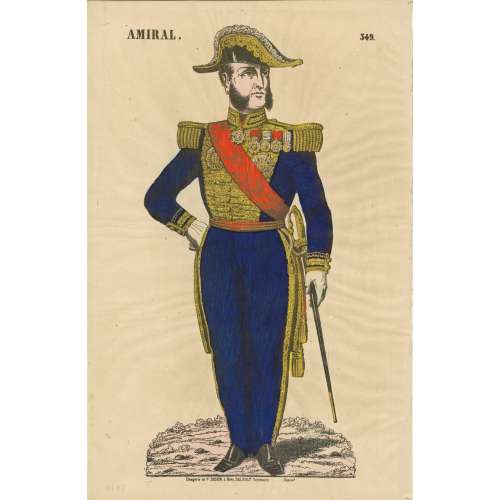 Hand-coloured woodcut on wove paper, 440 x 285 mm; black ink stamp “5049” to reverse. Top left: "AMIRAL"; right: "349". Below: "Imagerie de DIDION, à Metz, DELHALT Successeur." — "Déposé." Paulin Didion (French, 1831 – 1879) – publisher/printer.
Hand-coloured woodcut on wove paper, 440 x 285 mm; black ink stamp “5049” to reverse. Top left: "AMIRAL"; right: "349". Below: "Imagerie de DIDION, à Metz, DELHALT Successeur." — "Déposé." Paulin Didion (French, 1831 – 1879) – publisher/printer. -
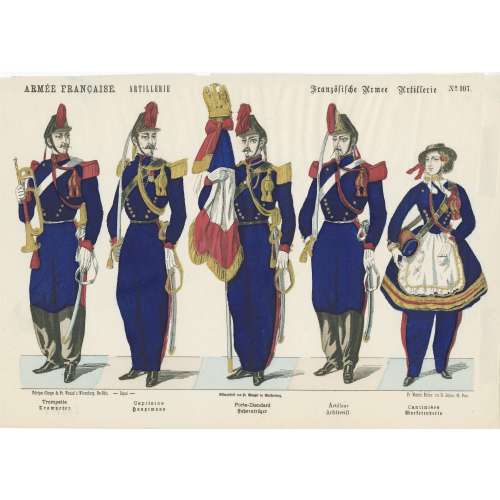 Hand-coloured woodcut on wove paper, 265 x 378 mm; black ink stamp “5051 1” to reverse. Top left: "ARMÉE FRANCAISE. ARTILLERIE"; right: (gothic font) "Französische Armee Artillerie" — "№ 107". Below left: "Fabrique d’Images de Fr. Wentzel à Wissembeurg. Bas-Rhin." — "Déposé" —, centre: "Bilderfabrit von Fr. Wentzel in Weissenburg", right: "Fr. Wentzel, Éditeur, rue St. Jacques, 65, Paris". Bottom: "Trompette | Trompeter" — "Capitaine | Gauptmann" — "Porte-Étendard | Fahnenträger" — "Artilleur | Artillerist" — "Cantinière | Marketenderin". Jean Frédéric Wentzel (French, 1807 – 1869) – publisher/printer.
Hand-coloured woodcut on wove paper, 265 x 378 mm; black ink stamp “5051 1” to reverse. Top left: "ARMÉE FRANCAISE. ARTILLERIE"; right: (gothic font) "Französische Armee Artillerie" — "№ 107". Below left: "Fabrique d’Images de Fr. Wentzel à Wissembeurg. Bas-Rhin." — "Déposé" —, centre: "Bilderfabrit von Fr. Wentzel in Weissenburg", right: "Fr. Wentzel, Éditeur, rue St. Jacques, 65, Paris". Bottom: "Trompette | Trompeter" — "Capitaine | Gauptmann" — "Porte-Étendard | Fahnenträger" — "Artilleur | Artillerist" — "Cantinière | Marketenderin". Jean Frédéric Wentzel (French, 1807 – 1869) – publisher/printer. -
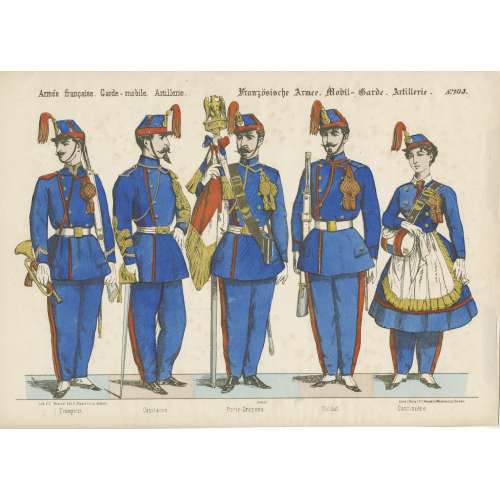 Hand-coloured woodcut on wove paper, 282 x 392 mm; black ink stamp “5051 2” to reverse. Top: "Armée française. Garde–mobile. Artillerie." — (gothic font) "Französische Armee. Mobil–Garde. Artillerie." — "№103". Below left: "Lith F. C. Wentzel édit. à Wissembourg. (Alsacé); center: Déposé; right: Druck u. Verlag v. F. C. Wentzel in Weissemburg. (Elsass)."; Bottom: "Trompette" — "Capitaine" — "Porte-Drapeau". — "Soldat" — "Cantinière." Jean Frédéric Wentzel (French, 1807 – 1869) – publisher/printer.
Hand-coloured woodcut on wove paper, 282 x 392 mm; black ink stamp “5051 2” to reverse. Top: "Armée française. Garde–mobile. Artillerie." — (gothic font) "Französische Armee. Mobil–Garde. Artillerie." — "№103". Below left: "Lith F. C. Wentzel édit. à Wissembourg. (Alsacé); center: Déposé; right: Druck u. Verlag v. F. C. Wentzel in Weissemburg. (Elsass)."; Bottom: "Trompette" — "Capitaine" — "Porte-Drapeau". — "Soldat" — "Cantinière." Jean Frédéric Wentzel (French, 1807 – 1869) – publisher/printer. -
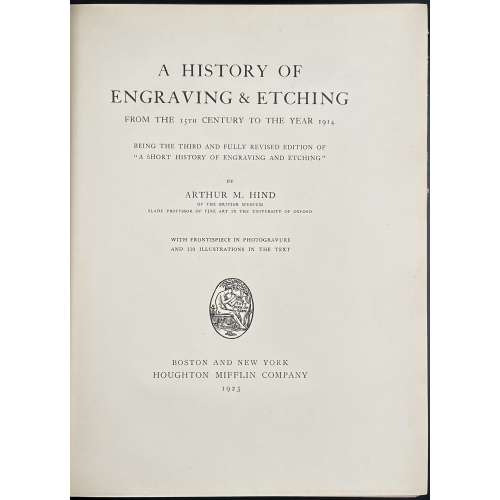 Title: A HISTORY OF | ENGRAVING & ETCHING | FROM THE 15TH CENTURY TO THE YEAR 1914 | BEING THE THIRD AND FULLY REVISED EDITION OF | “A SHORT HISTORY OF ENGRAVING AND ETCHING” | BY | ARTHUR M. HIND | OF THE BRITISH MUSEUM | SLADE PROFESSOR OF FINE ART IN THE UNIVERSITY OF OXFORD | WITH FRONTISPIECE IN PHOTOGRAVURE | AND 110 ILLUSTRATIONS IN THE TEXT | {publisher’s device} | BOSTON AND NEW YORK | HOUGHTON MIFFLIN COMPANY | 1923 || Pagination: [i-iv] v-xiii. [2] – blank / abbrev., [2] 3-487 [488], frontis. w/tissue guard, ills.; Appendices: I. Classified list of engravers (p. 343-392); II. General bibliography (p. 393-419); III. Index of engravers and individual bibliography (p. 420-487). Collation: π10 B-2H8 2I4, frontispiece (extr.), 110 in-text illustrations. Binding: 25.8 x 20 cm, crimson cloth, blind triple-fillet to top and bottom of the front board, same in gilt to spine, gilt lettering to spine, top edge gilt, fore-edge untrimmed. Contributors: Arthur Mayger Hind (British, 1880 – 1957) – author. Houghton Mifflin Company (Boston, 1864) – publisher. R & R. Clark, Ltd. (Edinburgh, 1846) – printer. Note: It is marked as the 3rd edition of A short history of engraving and etching. Indeed, A short history of engraving & etching for the use of collectors and students with full bibliography, classified list and index of engravers was published by Constable in London and Houghton Mifflin Co. in Boston, in 1908 and then in 1911. However, it is hard to consider an almost completely new book "a 3rd edition".
Title: A HISTORY OF | ENGRAVING & ETCHING | FROM THE 15TH CENTURY TO THE YEAR 1914 | BEING THE THIRD AND FULLY REVISED EDITION OF | “A SHORT HISTORY OF ENGRAVING AND ETCHING” | BY | ARTHUR M. HIND | OF THE BRITISH MUSEUM | SLADE PROFESSOR OF FINE ART IN THE UNIVERSITY OF OXFORD | WITH FRONTISPIECE IN PHOTOGRAVURE | AND 110 ILLUSTRATIONS IN THE TEXT | {publisher’s device} | BOSTON AND NEW YORK | HOUGHTON MIFFLIN COMPANY | 1923 || Pagination: [i-iv] v-xiii. [2] – blank / abbrev., [2] 3-487 [488], frontis. w/tissue guard, ills.; Appendices: I. Classified list of engravers (p. 343-392); II. General bibliography (p. 393-419); III. Index of engravers and individual bibliography (p. 420-487). Collation: π10 B-2H8 2I4, frontispiece (extr.), 110 in-text illustrations. Binding: 25.8 x 20 cm, crimson cloth, blind triple-fillet to top and bottom of the front board, same in gilt to spine, gilt lettering to spine, top edge gilt, fore-edge untrimmed. Contributors: Arthur Mayger Hind (British, 1880 – 1957) – author. Houghton Mifflin Company (Boston, 1864) – publisher. R & R. Clark, Ltd. (Edinburgh, 1846) – printer. Note: It is marked as the 3rd edition of A short history of engraving and etching. Indeed, A short history of engraving & etching for the use of collectors and students with full bibliography, classified list and index of engravers was published by Constable in London and Houghton Mifflin Co. in Boston, in 1908 and then in 1911. However, it is hard to consider an almost completely new book "a 3rd edition". -
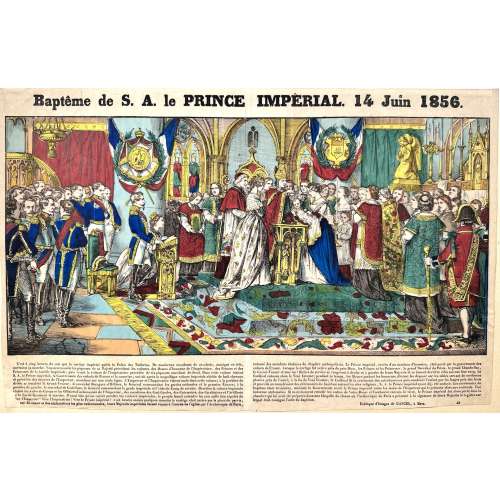 Hand-coloured woodcut on wove paper, 610 x 390 mm; black ink stamp “5207” to reverse, attached to a larger sheet of thick paper with a red ink stamp: “COLLECTION JEAN-CLAUD LACHNITT | REPRODUCTION INTERDIT”. Top: Baptême de S. A. le PRINCE IMPÉRIAL. 14 Juin 1856; image of baptism of Prince-Impérial; two-column text with a small loss in the lower left corner (C'est à cinq heures du soir que le cortège impérial quitta le Palais des Tuileries. De nombreux escadrons de cavalerie, musique en tête ouvraient la marche. ...); bottom under the text: "Fabrique d'Images de GANGEL, à Metz." — "49".
Hand-coloured woodcut on wove paper, 610 x 390 mm; black ink stamp “5207” to reverse, attached to a larger sheet of thick paper with a red ink stamp: “COLLECTION JEAN-CLAUD LACHNITT | REPRODUCTION INTERDIT”. Top: Baptême de S. A. le PRINCE IMPÉRIAL. 14 Juin 1856; image of baptism of Prince-Impérial; two-column text with a small loss in the lower left corner (C'est à cinq heures du soir que le cortège impérial quitta le Palais des Tuileries. De nombreux escadrons de cavalerie, musique en tête ouvraient la marche. ...); bottom under the text: "Fabrique d'Images de GANGEL, à Metz." — "49". -
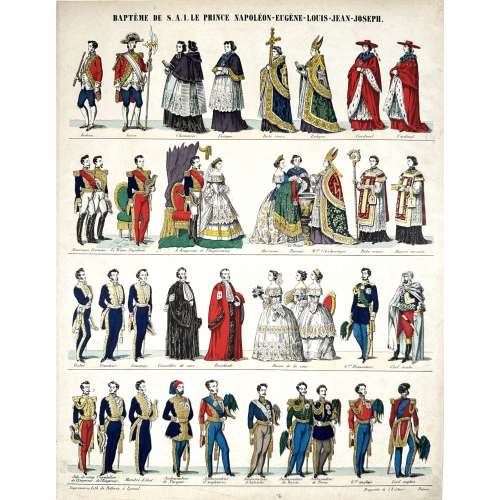 Hand-coloured woodcut on wove paper, 460 x 363 mm; black ink stamp “5054” to reverse. Four tiers with groups of people dressed in uniform, captioned: Bedeau — Suisse — Chanoines — Évêque — Porte croix — Évêque — Cardinal — Cardinal | Généraux français — Le prince Napoléon — L’Empereur et l’Impératrice — Marraine — Le Prince — Parrain | Meur l’Archevêque | Porte crosse Diacre servant | Préfet — Sénateur — Conseiller de cour — Président — Dames de la cour — Gral Piémontais — Chef arabe | Aide-de-camp de l’Empereur — Chambellan de l’Empereur — Ministre d’état — Ambassadeur de Turque | Ambassadeur d’Angleterre — Ambassadeur d’Autriche — Ambassadeur de Russie — Ambassadeur de Prusse — Gral anglaise — Lord anglais || Bottom left: Imprimerie Lith. de Pellerin, à Épinal; right: Propriété de l’Éditeur. — Déposé. Jean Charles Pellerin (French, 1756 – 1836) – printer/publisher.
Hand-coloured woodcut on wove paper, 460 x 363 mm; black ink stamp “5054” to reverse. Four tiers with groups of people dressed in uniform, captioned: Bedeau — Suisse — Chanoines — Évêque — Porte croix — Évêque — Cardinal — Cardinal | Généraux français — Le prince Napoléon — L’Empereur et l’Impératrice — Marraine — Le Prince — Parrain | Meur l’Archevêque | Porte crosse Diacre servant | Préfet — Sénateur — Conseiller de cour — Président — Dames de la cour — Gral Piémontais — Chef arabe | Aide-de-camp de l’Empereur — Chambellan de l’Empereur — Ministre d’état — Ambassadeur de Turque | Ambassadeur d’Angleterre — Ambassadeur d’Autriche — Ambassadeur de Russie — Ambassadeur de Prusse — Gral anglaise — Lord anglais || Bottom left: Imprimerie Lith. de Pellerin, à Épinal; right: Propriété de l’Éditeur. — Déposé. Jean Charles Pellerin (French, 1756 – 1836) – printer/publisher. -
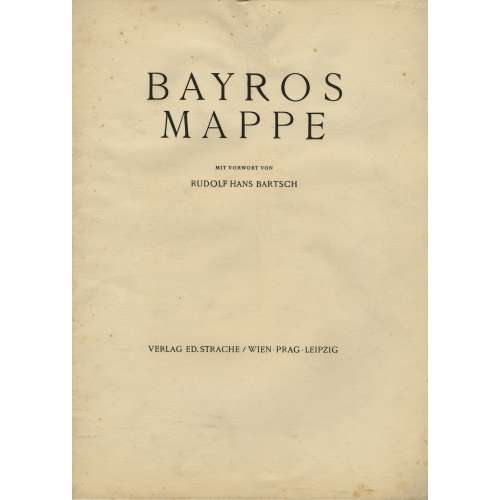 An album 45 of 50 prints, 31 photogravures and 14 in raster chromotype after drawings and paintings by Franz von Bayros; most with tissue guards, some in passepartout; colour prints mounted on the same paper that is used for photogravures. Title-page: BAYROS | MAPPE | MIT VORWORT VON | RUDOLF HANS BARTSCH | VERLAG ED. STRACHE / WIEN • PRAG • LEIPZIG || Limited edition of 500 copies. This is copy № 286. Lacking 5 prints: (1) Abschied vom Paradies, (2) Weihnacht, and (3) Harmonie from Symphonie von der Gūte, die Schönheit ist; (4) Divina commedia from Florentiner Phantasien; and (5) Mozart from Varia. Contributors: Franz von Bayros (Austrian, 1866 – 1924) Rudolf Hans Bartsch (Austrian, 1873 – 1952)
An album 45 of 50 prints, 31 photogravures and 14 in raster chromotype after drawings and paintings by Franz von Bayros; most with tissue guards, some in passepartout; colour prints mounted on the same paper that is used for photogravures. Title-page: BAYROS | MAPPE | MIT VORWORT VON | RUDOLF HANS BARTSCH | VERLAG ED. STRACHE / WIEN • PRAG • LEIPZIG || Limited edition of 500 copies. This is copy № 286. Lacking 5 prints: (1) Abschied vom Paradies, (2) Weihnacht, and (3) Harmonie from Symphonie von der Gūte, die Schönheit ist; (4) Divina commedia from Florentiner Phantasien; and (5) Mozart from Varia. Contributors: Franz von Bayros (Austrian, 1866 – 1924) Rudolf Hans Bartsch (Austrian, 1873 – 1952) -
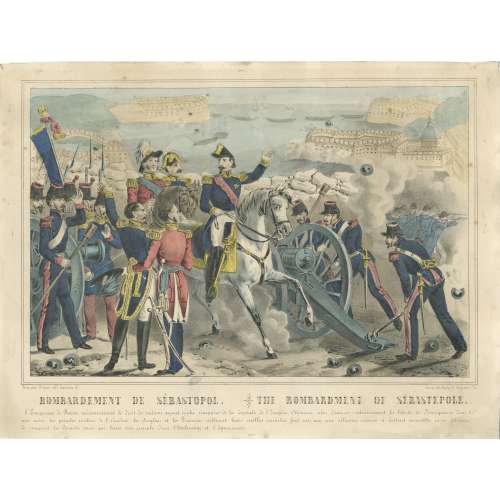 Hand-coloured lithography on wove paper, 250 x 332 mm; black ink stamp “5035” to reverse. Under the frame left: "Paris, chez Riboni, éd. r. Galande, 51"; right: "Paris, lith. Bulla, Pl. Maubert, 26". Below: "BOMBARDEMENT DE SEBASTOPOL. — THE BOMBARDMENT OF SÉBASTOPOLE". Text to bottom. Printers/publishers: Antoine Bulla (fl. 1815 – 1877), François Bulla (fl. c. 1814 – 1855).
Hand-coloured lithography on wove paper, 250 x 332 mm; black ink stamp “5035” to reverse. Under the frame left: "Paris, chez Riboni, éd. r. Galande, 51"; right: "Paris, lith. Bulla, Pl. Maubert, 26". Below: "BOMBARDEMENT DE SEBASTOPOL. — THE BOMBARDMENT OF SÉBASTOPOLE". Text to bottom. Printers/publishers: Antoine Bulla (fl. 1815 – 1877), François Bulla (fl. c. 1814 – 1855). -
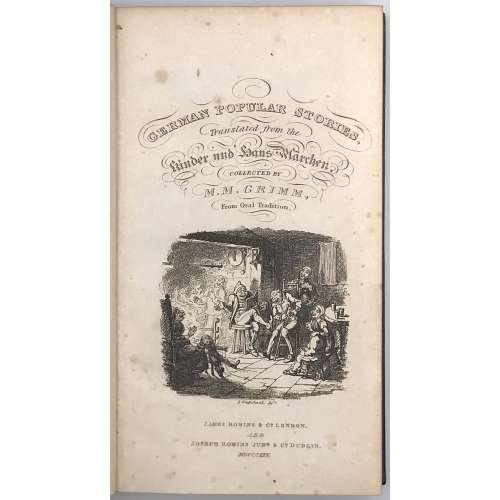 A two-volume set. Volume 1: GERMAN POPULAR STORIES | translated from the | Kinder und Haus Märchen, | COLLECTED BY | M. M. GRIMM, | from oral tradition. | [Vignette] | JAMES ROBINS & Co. LONDON. |AND | JOSEPH ROBINS JUNR & Co. DUBLIN. | MDCCCXXV.|| 12mo, pp. xii, 240; engraved title vignette and 11 plates by George Cruikshank, with a fine proof (?) of the plate illustrating ‘The Jew in the bush’ on India paper laid onto verso of leaf bound between half-title and title. Table of contents: Hans in luck -- The travelling musicians -- The golden bird -- The fisherman and his wife -- The tom-tit and the bear -- The twelve dancing princesses -- Rose-bud -- Tom thumb -- The grateful beasts -- Jorinda and Jorindel -- The waggish musician -- The queen bee -- The dog and the sparrow -- Frederick and Catherine -- The three children of fortune -- King grisly-beard -- The adventures of chanticleer and partlet -- Snow-drop -- The elves and the shoemaker -- The turnip -- Old sultan -- The lady and the lion -- The jew in the bush -- The king of the golden mountain -- The golden goose -- Mrs. fox -- Hansel and Grettel -- The giant with the three golden hairs -- The frog prince -- The fox and the horse -- Rumpel-stilts-kin.; Volume 2: GERMAN POPULAR STORIES | translated from the | Kinder und Haus Märchen, | COLLECTED BY | M. M. GRIMM, | from oral tradition. | [Vignette] | JAMES ROBINS & Co. LONDON. |AND | JOSEPH ROBINS JUNR & Co. DUBLIN. | MDCCCXXVI.|| 12mo, iv, 256, [2]; engraved title vignette and 9 plates by George Cruikshank. Table of contents: The goose-girl -- Faithful John -- The blue light -- Ashputtel -- The young giant and the tailor -- The crows and the soldier -- Pee-wit -- Hans and his wife Grettel -- Cherry, or the frog-bride -- Mother Holle -- The water of life -- Peter the goatherd -- The four clever brothers -- The elfin-grove -- The salad -- The nose -- The five servants -- Cat-skin -- The robber-bridegroom -- The three sluggards -- The seven ravens -- Roland and may-bird -- The mouse, the bird, and the sausage -- The juniper tree. Binding: bound without advertisements in 19th-century brown morocco by Leighton, spines decorated and lettered in gilt, gilt edges, marbled endpapers; armorial bookplates of Thomas Gaisford and Charles Tennant to endpapers. Note: The third edition of vol. 1 (first C. Baldwyn 1823) and the first edition of vol. 2 of the first English translation of Grimm’s Fairy Tales – including Tom Thumb, the Elves and the Shoemaker, Hansel and Grettel, the Frog Prince, and Rumpelstiltskin – with George Cruikshank’s celebrated illustrations. Of Cruikshank’s work, Ruskin remarked, ‘The etchings are the finest things, next to Rembrandt’s, that, as far as I know, has been done since etching was invented. You cannot look at them too much, nor copy them too often’ (The Elements of Drawing, 1857). Provenance: (1) Thomas Gaisford (1779-1855), classical scholar, Regius Professor of Greek at Oxford University, Dean of Christ Church, curator of the Bodleian Library and delegate of the Clarendon Press. (2) Sir Charles Tennant, 1st Baronet (1823-1906), a Scottish industrialist who amassed a notable library and collection of pictures at his Peeblesshire estate, ‘The Glen’. Catalogue raisonné: Albert M. Cohn 369.
A two-volume set. Volume 1: GERMAN POPULAR STORIES | translated from the | Kinder und Haus Märchen, | COLLECTED BY | M. M. GRIMM, | from oral tradition. | [Vignette] | JAMES ROBINS & Co. LONDON. |AND | JOSEPH ROBINS JUNR & Co. DUBLIN. | MDCCCXXV.|| 12mo, pp. xii, 240; engraved title vignette and 11 plates by George Cruikshank, with a fine proof (?) of the plate illustrating ‘The Jew in the bush’ on India paper laid onto verso of leaf bound between half-title and title. Table of contents: Hans in luck -- The travelling musicians -- The golden bird -- The fisherman and his wife -- The tom-tit and the bear -- The twelve dancing princesses -- Rose-bud -- Tom thumb -- The grateful beasts -- Jorinda and Jorindel -- The waggish musician -- The queen bee -- The dog and the sparrow -- Frederick and Catherine -- The three children of fortune -- King grisly-beard -- The adventures of chanticleer and partlet -- Snow-drop -- The elves and the shoemaker -- The turnip -- Old sultan -- The lady and the lion -- The jew in the bush -- The king of the golden mountain -- The golden goose -- Mrs. fox -- Hansel and Grettel -- The giant with the three golden hairs -- The frog prince -- The fox and the horse -- Rumpel-stilts-kin.; Volume 2: GERMAN POPULAR STORIES | translated from the | Kinder und Haus Märchen, | COLLECTED BY | M. M. GRIMM, | from oral tradition. | [Vignette] | JAMES ROBINS & Co. LONDON. |AND | JOSEPH ROBINS JUNR & Co. DUBLIN. | MDCCCXXVI.|| 12mo, iv, 256, [2]; engraved title vignette and 9 plates by George Cruikshank. Table of contents: The goose-girl -- Faithful John -- The blue light -- Ashputtel -- The young giant and the tailor -- The crows and the soldier -- Pee-wit -- Hans and his wife Grettel -- Cherry, or the frog-bride -- Mother Holle -- The water of life -- Peter the goatherd -- The four clever brothers -- The elfin-grove -- The salad -- The nose -- The five servants -- Cat-skin -- The robber-bridegroom -- The three sluggards -- The seven ravens -- Roland and may-bird -- The mouse, the bird, and the sausage -- The juniper tree. Binding: bound without advertisements in 19th-century brown morocco by Leighton, spines decorated and lettered in gilt, gilt edges, marbled endpapers; armorial bookplates of Thomas Gaisford and Charles Tennant to endpapers. Note: The third edition of vol. 1 (first C. Baldwyn 1823) and the first edition of vol. 2 of the first English translation of Grimm’s Fairy Tales – including Tom Thumb, the Elves and the Shoemaker, Hansel and Grettel, the Frog Prince, and Rumpelstiltskin – with George Cruikshank’s celebrated illustrations. Of Cruikshank’s work, Ruskin remarked, ‘The etchings are the finest things, next to Rembrandt’s, that, as far as I know, has been done since etching was invented. You cannot look at them too much, nor copy them too often’ (The Elements of Drawing, 1857). Provenance: (1) Thomas Gaisford (1779-1855), classical scholar, Regius Professor of Greek at Oxford University, Dean of Christ Church, curator of the Bodleian Library and delegate of the Clarendon Press. (2) Sir Charles Tennant, 1st Baronet (1823-1906), a Scottish industrialist who amassed a notable library and collection of pictures at his Peeblesshire estate, ‘The Glen’. Catalogue raisonné: Albert M. Cohn 369. -
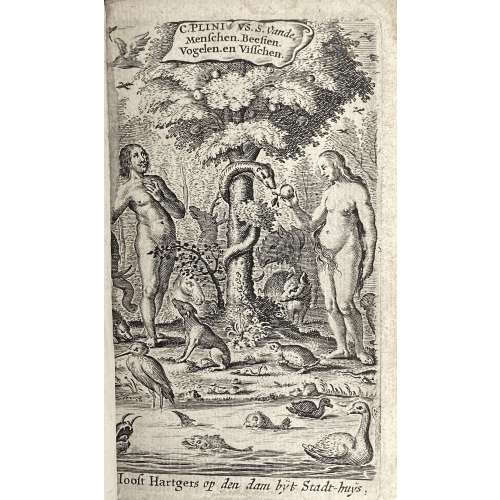 Pliny's Historia Naturalis. Engraved Title: C. PLINIUS S. Vande Menfchen, Beeften, Vogelen en Viffchen. [Pliny the Elder. Of Men, Beasts, Birds, and Fish]. Title: C. PLINII | SECUNDI | Des wijd-vermaerden Na- | tuur-kondigers vijf boecken handelende van de nature. | Handelende van de Nature | I. Vande Manfchen. | II. Vande viervoetige en kruypende Dieren. | III. Vande Vogelen. | IV. Vande kleyne Beeftjes of Ongedierten. | V. Vande Viffchen, Oefters, Kreeften, &c. | Hier zijn by ghevoeght / de Schriften | van verscheyden andere oude autheuren / de | natuer der dieren aengaende; | En nu in defen leften Druck wel het vierde part | vermeerdert , uyt verscheyden nieuwe Schrijvers | en eyghen ondervindinge : en met veel | kopere Plaeten verciert. {Device} | t' AMSTELREDAM , | By Iooft Hartgers, Boeck-verkooper op den Dam | bezijden het Stadthuys, 1650. Pagination: [1, 2] - engraved t.p. / blank, [3, 4] - text t.p. / Aen den nauw-keuringem Lefer..., 5-802, 52 engraved plates; colophon on p. 802 bottom: "Gedruckt by Chiftoffel Cunradus, ..." Collation: A-Z1-12, Aa-Kk1-12 Size: 12mo, 14 x 9 cm Binding: Vellum The first Dutch version, consisting of extracts from books 7-11 from Pliny's "Natural History" was published in Arnheim by Jans Janzen in quarto in 1610. Our copy is one of the Amsterdam editions and the only one in duodecimo. According to WorldCat, there is not a single copy of this edition in the US libraries. Printed by Christoffel Cunradus ( Freiberg , c. 1615 - Amsterdam , 1684) for publisher Joost Hartgers (Dutch, fl. 1650). See Gudger, E. W. "Pliny's Historia Naturalis. The Most Popular Natural History Ever Published." Isis 6, no. 3 (1924): 269-81. Accessed September 23, 2020. http://www.jstor.org/stable/224311.
Pliny's Historia Naturalis. Engraved Title: C. PLINIUS S. Vande Menfchen, Beeften, Vogelen en Viffchen. [Pliny the Elder. Of Men, Beasts, Birds, and Fish]. Title: C. PLINII | SECUNDI | Des wijd-vermaerden Na- | tuur-kondigers vijf boecken handelende van de nature. | Handelende van de Nature | I. Vande Manfchen. | II. Vande viervoetige en kruypende Dieren. | III. Vande Vogelen. | IV. Vande kleyne Beeftjes of Ongedierten. | V. Vande Viffchen, Oefters, Kreeften, &c. | Hier zijn by ghevoeght / de Schriften | van verscheyden andere oude autheuren / de | natuer der dieren aengaende; | En nu in defen leften Druck wel het vierde part | vermeerdert , uyt verscheyden nieuwe Schrijvers | en eyghen ondervindinge : en met veel | kopere Plaeten verciert. {Device} | t' AMSTELREDAM , | By Iooft Hartgers, Boeck-verkooper op den Dam | bezijden het Stadthuys, 1650. Pagination: [1, 2] - engraved t.p. / blank, [3, 4] - text t.p. / Aen den nauw-keuringem Lefer..., 5-802, 52 engraved plates; colophon on p. 802 bottom: "Gedruckt by Chiftoffel Cunradus, ..." Collation: A-Z1-12, Aa-Kk1-12 Size: 12mo, 14 x 9 cm Binding: Vellum The first Dutch version, consisting of extracts from books 7-11 from Pliny's "Natural History" was published in Arnheim by Jans Janzen in quarto in 1610. Our copy is one of the Amsterdam editions and the only one in duodecimo. According to WorldCat, there is not a single copy of this edition in the US libraries. Printed by Christoffel Cunradus ( Freiberg , c. 1615 - Amsterdam , 1684) for publisher Joost Hartgers (Dutch, fl. 1650). See Gudger, E. W. "Pliny's Historia Naturalis. The Most Popular Natural History Ever Published." Isis 6, no. 3 (1924): 269-81. Accessed September 23, 2020. http://www.jstor.org/stable/224311.


